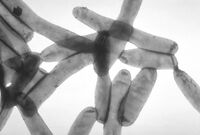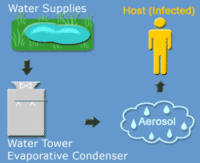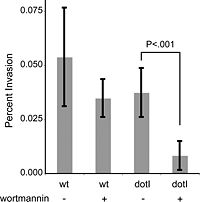Legionella pneumophila
| Legionella pneumophila | ||||||||||||||
|---|---|---|---|---|---|---|---|---|---|---|---|---|---|---|
 | ||||||||||||||
| Scientific classification | ||||||||||||||
| ||||||||||||||
| Binomial name | ||||||||||||||
| Legionella pneumophila |
Description and significance
Legionella pneumophila is a rod shaped, flagellated Gram-negative bacterium. ‘‘L. pneumophila’’ is aerobic and non-capsulated. It is known to be pathogenic to humans and leads to Legionellosis or Legionnaires disease. The name Legionnaires comes from an outbreak of this disease during a convention of the American Legion in 1976.[1] ‘‘L. pneumophila’’ is determined to be the dominant human pathogen in its genus of 41 different species . It was first found to be pathogenic in 1976 when a group of men were found to be infected. It spread to more than 200 individuals and led to 34 casualties. It was first isolated by inoculation of a guinea pig with the blood sample of an infected person in 1947. [2] Although, other species from the genus Legionella can lead to Legionnaires disease, ‘‘L. pneumophila’’ is known to be responsible for most human infections. [3] After substantial amount of research I have arrived at the conclusion that there are no significant uses of ‘‘L. pneumophila’’ in biotechnology.
Genome structure
Overall there are 41 different species identified in the genus Legionella. These species are further divided into a total of 64 serogroups Species is also divided into several serogroups. Three of these, seroroups 1, 4 and 6 have been studied well. These are also known as Legionella pneumophila str. Paris, Legionella pneumophila str. Lens and Legionella pneumophila ssp. Pneumophila str. Philadelphia 1. Sequencing of all three of these genomes has been completed recently between 2001 and 2004. [4] One of the most essential functions in ‘‘L. pneumophila’’’s pathogenic behavior is the escaping from the host cell after having multiplied. This use of type IV secretion has been identified and studied during the process of lysis. The gene related to type IV secretion has been found to be dot/icm gene complex. [5]
| Name | Genes | Base Pairs | Year |
|---|---|---|---|
| Legionella pneumophila str. Paris | 3136 | 3,503,610 | 2004 |
| Legionella pneumophila str. Lens | 3001 | 3,345,687 | 2004 |
| Legionella pneumophila ssp. Pneumophila str. Philadelphia 1 | 3002 | 3,397,754 | 2001 |
Cell structure and metabolism
‘‘L. pneumophila’’ is a flagellated Gram-negative bacterium. It has a rod-like (bacillus) shape, and uses aerobic respiration. They are unable to capsulate, sporulate or ferment. As for light, they do not have pigments and are unable to autoflourescence. Although it is a Gram-negative bacterium, it is still difficult to stain ‘‘L. pneumophila’’ due to certain lippolysaccharides in their cell membrane. A minimum of 35 antigens have already been identified from ‘‘L. pneumophila’’. As for the size, it is approximately 2 µm in length and 0.3-0.9 µm in width. The shape changes, by increasing the length, when under poor nutritional conditions. The cell membrane contains a lipopolysaccharide which initiates the immune response of the host. This lipopolysaccharide has been extensively researched. The lipopolysaccharide in ‘‘L. pneumophila’’ has a significantly weaker interaction with CD14 receptor proteins of other cells, compared to the interaction strength of lipopolysaccharides found in other bacteria, such as enterobacteria. This weaker interaction reduces the endotoxic effects of ‘‘L. pneumophila’’. The antigens located on the cell membrane are used to identify the different serogroups in the genus pneumophila.[6]
Ecology
In general ‘‘L. pneumophila’’ can be found in aquatic environments worldwide.[7] ‘‘L. pneumophila’’ can be found in many large water systems, such as those used in buildings. It often ends up in the heating and cooling components of residential apartments. If such water systems are left unchecked, it can lead to outbreaks of Legionnaires disease.[8] Furthermore studies have shown that ‘‘L. pneumophila’’ thrives in water tanks for two primary reasons. Firstly, many water tanks show the presence of sediments, which acts as a nutrient source for ‘‘L. pneumophila’’. Secondly many water tanks are kept at elevated temperature, which makes it easier for ‘‘L. pneumophila’’ to survive. [9] To prevent ‘‘L. pneumophila’’ from contaminating a water source, there has to be a continous treatment of the water with monochloramine or copper-silver ions. Furthermore water temperature must be maintained at 55ºC. ‘‘L. pneumophila’’ have a high resistancey to commonly used chemical disinfectants. If they are present inside amoebae, they also show considerable resistance to fluctuation in temperatures, PH, osmolarity and oxidizing agents. Although ‘‘L. pneumophila’’ have gained fame for being parasitic towards humans, their true historical host have been protozoan. ‘‘L. pneumophila’’ has been found to be parasitic towards 14 different species of amoebae and 2 species of other ciliated protozoan. They generally perform better in hosts which specialize in phagocytosis. This is the reason why ‘‘L. pneumophila’’ are more pathogenic towards macrophages in humans (Current Research section includes a research on this topic). [10]
Pathology
‘‘L. pneumophila’’ is known to infect protozoans mostly, but sometimes these infections also occur in humans and other mammals. ‘‘L. pneumophila’’ enters the human body through the lungs and attacks the immune system cells. When invading macrophages in humans it behaves similarly to when it invades protozoan cells. When ‘‘L. pneumophila’’ enters a cell, it inhibits phagolysosome fusion, which disables the host cell’s major defense mechanism. Then ‘‘L. pneumophila’’ multiplies within a membrane, which is known to behave similarly to endoplasmic reticulum. Finally when it is ready to release, it uses type IV secretion system to lyse the host cell. This causes an inflammatory response in humans, which worsens the situation because it attracts more macrophages and thereby provides more host cells for ‘‘L. pneumophila’’ invasions. [11] Infection by ‘‘L. pneumophila’’ in humans is called Legionnaires disease or Legionellosis. Once infected there are two possibilities: the person might develop pneumonia, which is the more dangerous version of the disease, or the person might develop Pontiac fever, which is usually nonfatal. Many cases of Legionnaires disease go unnoticed because infections of Legionnaires disease are often reported as respiratory infections and in some cases a treatment for respiratory infections can also treat the Legionnaires disease. [12] People of all ages are susceptible to Legionnaires disease, but it is more fatal to people with chronic lung disease, smoking habits and a compromised immune system.[13] Furthermore, Legionnaires disease can’t be passed on directly from person to person. In fact, the only way for it to be passed on is through aerosolization or aspiration of water.[14] There are 41 different species in the genus Legionella and these are further divided into 64 serogroups. The serogroups 1, 4, and 6 are responsible for most human infections of Legionnaires disease. Serogroup 1 is determined to be the cause of 70-90% of such infections. Studies show approximately only 5-15% of Legionnaires disease cases are fatal. A recent case, in January 2009, of Legionnaires disease has occurred at a recently opened luxurious hotel in Dubai. Three individuals who had been residing at Westin Dubai Mina Seyahi Beach Resort reported severe illness after leaving the hotel. Furthermore, one of the three individual, who was a famous Cricket Broadcaster in Britain, passed away after battling the disease for a short period. The other two individuals continue to struggle with Legionnaires’ disease. The hotel authorities have cooperated and allowed the testing for Legionella bacteria in the hotel; so far all results have returned negatively.[15]
Macrolides (azithromycin) or fluoroquinolones (moxifloxacin) are two drugs that are commonly used for treating ‘‘L. pneumophila’’ in people.
| Year | Male | Female | Total |
|---|---|---|---|
| 1999 | 42 | 14 | 56 |
| 2000 | 125 | 29 | 154 |
| 2001 | 78 | 8 | 86 |
| 2002 | 139 | 29 | 167 |
| 2003 | 127 | 20 | 147 |
| 2004 | 151 | 9 | 160 |
| 2005 | 252 | 29 | 281 |
| 2006 | 452 | 66 | 518 |
| 2007 | 527 | 141 | 668 |
| 2008 | 529 | 157 | 686 |
Current Research
Research I
One study tests the ability of ‘‘L. pneumophila’’ to invade and reproduce in other types of cells in the human body besides macrophages. In this case endothelial cells from human umbilical vein were used. There were two types of ‘‘L. pneumophila’’ bacteria used; one was a strain called Lp01 and the other was a mutated form of ‘‘L. pneumophila’’ called dotI (HL051C). This mutant lacks the ability to inhibit phagolysosome fusion. Furthermore both type of ‘‘L. pneumophila’’ were tested with and without the presence of wortmannin, which inhibits PI-3 kinase. Wortmannin had previously demonstrated that the Lp01 strand (wild type) and dotI (mutant) use different pathways because wortmannin was successfully able to reduce invasions by dotI in macrophages, while having little effect on the wild type. For this to hold true, wortmannin should also demonstrate similar results when invading other types of cells. The results of this experiment show that overall invasion was nearly a hundred times less frequent in endothelial cells compared to macrophage cells. The primary reason being ‘‘L. pneumophila’’ find it easier to invade macrophages because they are specialized phagocytes. The second part of this study shows that when comparing the wild type and mutant, the mutant did show reduced ability to invade endothelial cells but the difference was considered insignificant. As for the last part of this study, in the presence of wortmannin the mutant showed a significantly larger decline compared to the decline faced by the wild type.[16]
Research II
Another recent study, April 18th 2009, revealed shocking data. Legionnaire’s disease, which was originally thought to be only possible by aerosols contaminations, is now showing signs of having spread through potting soil. Many cases have been reported to have occurred in Switzerland. In this study 46 samples of various commercial potting soils have been taken and tested for presence of legionnaire’s disease causing species. 21 of the 46 samples have confirmed the presence of Legionella spp. 9 of these samples showed the presence of ‘‘L. pneumophila’’. Furthermore results from real-time PCR showed that these bacteria were present at high concentration. The potting soil available to the public in Switzerland could be a reservoir for ‘‘L. pneumophila’’ and other legionnaire’s disease causing bacteria. A high probability of an outbreak currently exists in Switzerland. This research shows that the potential of Legionnaire’s disease had been severely underestimated. Further research is being done to reaffirm the findings and to test other possible reservoir for Legionella spp. [17]
- ↑ "Legionellosis (Legionnaires' Disease) in Adults: Condition, Treatment and Pictures - Overview - VisualDxHealth�." VisualDxHealth | Your guide to a clear picture of health. 11 May 2009 <http://www.visualdxhealth.com/atlas/legionellosisLegionnairesDisease.htm>.
- ↑ Lederberg, Joshua et al. Legionella. Encyclopedia of Microbiology. Second Edition. Volume 3. San Diego, 2000. p. 19
- ↑ Rathore, Mobeen, MD.Legionella Infection. eMedicine. 2006.
- ↑ "Genome Home." NCBI HomePage. 11 May 2009 <http://www.ncbi.nlm.nih.gov/sites/entrez?db=Genome&itool=toolbar>.
- ↑ Segal G, Purcell M, Shuman HA (1998) Host cell killing and bacterial conjugation require overlapping sets of genes within a 22-kb region of the ‘‘L. pneumophila’’ genome. Proc Natl Acad Sci U S A 95: 1669–1674.
- ↑ Lederberg, Joshua et al. Legionella. Encyclopedia of Microbiology. Second Edition. Volume 3. San Diego, 2000. p. 19-20
- ↑ (enter reference)
- ↑ "Legionellosis (Legionnaires' Disease) in Adults: Condition, Treatment and Pictures - Overview - VisualDxHealth�." VisualDxHealth | Your guide to a clear picture of health. 11 May 2009 <http://www.visualdxhealth.com/atlas/legionellosisLegionnairesDisease.htm>.
- ↑ Stout JE, Yu VL, Best MG. Ecology of ‘‘L. pneumophila’’ within water distribution systems. Appl Environ Microbiol. 1985. Volume 1. p. 221-228.
- ↑ Friedman, Herman, and Mauro Bendinelli. Legionella Pneumophila Pathogenesis and Immunity (Infectious Agents and Pathogenesis). New York: Springer, 2007.
- ↑ "PLoS ONE: Infection of Cultured Human Endothelial Cells by Legionella pneumophila." PLoS ONE : accelerating the publication of peer-reviewed science. 1 May 2009 <http://www.plosone.org/article/info:doi/10.1371/journal.pone.0002012
- ↑ "Legionellosis (Legionnaires' Disease) in Adults: Condition, Treatment and Pictures - Overview - VisualDxHealth�." VisualDxHealth | Your guide to a clear picture of health. 1 May 2009 <http://www.visualdxhealth.com/atlas/legionellosisLegionnairesDisease.htm>.
- ↑ "Legionella pneumophilia - Information and Epidemiology Services." Public Health Consulting & Food Safety Consultants | EHA Consulting Group. 1 May 2009 <http://www.ehagroup.com/resources/pathogens/legionella-pneumophilia>.
- ↑ "Legionella pneumophilia - Information and Epidemiology Services." Public Health Consulting & Food Safety Consultants | EHA Consulting Group. 1 May 2009 <http://www.ehagroup.com/resources/pathogens/legionella-pneumophilia>.
- ↑ "Hotel Sick || HotelChatter." Hotel Reviews, Hotel Ratings, Hotel Openings || HotelChatter. 28 Apr. 2009 <http://www.hotelchatter.com/tag/Hotel%20Sick>.
- ↑ Chiaraviglio L, Brown DA, Kirby JE (2008) Infection of Cultured Human Endothelial Cells by ‘‘L. pneumophila’’. PLoS ONE 3(4): e2012. doi:10.1371/journal.pone.0002012
- ↑ "Commercial potting soils as an alternative infecti...[Clin Microbiol Infect. 2009] - PubMed Result." NCBI HomePage. 11 May 2009 <http://www.ncbi.nlm.nih.gov/pubmed/19392903?ordinalpos=4&itool=EntrezSystem2.PEntrez.Pubmed.Pubmed_ResultsPanel.Pubmed_DefaultReportPanel.Pubmed_RVDocSum>.

